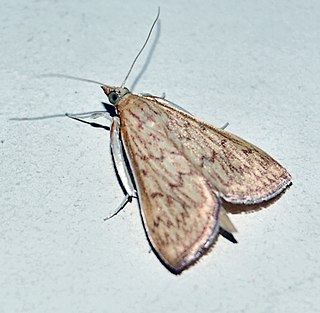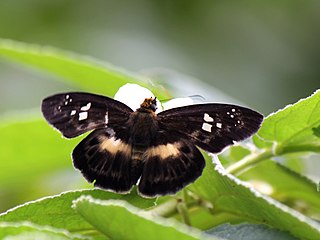
Lepidoptera or lepidopterans is an order of winged insects that includes butterflies and moths. About 180,000 species of the Lepidoptera have been described, representing 10% of the total described species of living organisms, making it the second largest insect order with 126 families and 46 superfamilies. and one of the most widespread and widely recognizable insect orders in the world.

The Pyralidae, commonly called pyralid moths, snout moths or grass moths, are a family of Lepidoptera in the ditrysian superfamily Pyraloidea. In many classifications, the grass moths (Crambidae) are included in the Pyralidae as a subfamily, making the combined group one of the largest families in the Lepidoptera. The latest review by Eugene G. Munroe and Maria Alma Solis retain the Crambidae as a full family of Pyraloidea.

Acherontia styx, the lesser death's head hawkmoth or bee robber, is a sphingid moth found in Asia, one of the three species of death's-head hawkmoth. It is very fond of honey, and bee keepers have reported finding dead moths in their hives as a result of bee stings. They can mimic the scent of bees so that they can enter a hive unharmed to get honey. Their tongue, which is stout and very strong, enables them to pierce the wax cells of the beehive and suck the honey out. They are also known to be a pest of yuzu in South Korea, using their tongue to pierce and damage the fruit.
Agathiphaga is a genus of moths, known as kauri moths. and is the only living genus in the family Agathiphagidae. This caddisfly-like lineage of primitive moths was first reported by Lionel Jack Dumbleton in 1952, as a new genus of Micropterigidae.
Atasthalistis is a genus of moths in the family Gelechiidae.

Antigastra catalaunalis is a species of moth of the family Crambidae. The species was first described by Philogène Auguste Joseph Duponchel in 1833. It is endemic to tropical and subtropical areas, but is also found in other areas due to its migratory nature.

Gerosis is an Indomalayan genus of spread-winged skippers in the family Hesperiidae.There are six species found from China and Northeast India to Java and the Sula Archipelago east of Sulawesi.They are lowland forest butterflies. They seek sunny areas between 1 and 4 metres above ground, but females can be encountered in the shade.

Gynaephora groenlandica, the Arctic woolly bear moth, is an erebid moth native to the High Arctic in the Canadian archipelago, Greenland and Wrangel Island in Russia. It is known for its slow rate of development, as its full caterpillar life cycle may extend up to 7 years, with moulting occurring each spring. This species remains in a larval state for the vast majority of its life. Rare among Lepidoptera, it undergoes an annual period of diapause that lasts for much of the calendar year, as G. groenlandica is subject to some of the longest, most extreme winters on Earth. In this dormant state, it can withstand temperatures as low as −70 °C. The Arctic woolly bear moth also exhibits basking behavior, which aids in temperature regulation and digestion and affects both metabolism and oxygen consumption. Females generally do not fly, while males usually do.

Pergesa is a monotypic moth genus in the family Sphingidae first described by Francis Walker in 1856. Its only species, Pergesa acteus, the green pergesa hawkmoth, was described by Pieter Cramer in 1779.
Scopula actuaria is a moth of the family Geometridae. It was described by Francis Walker in 1861. It is found throughout the Oriental tropics of India, Sri Lanka, from Afghanistan and Taiwan to the southern Moluccas and Timor. It is also found on the Chagos Archipelago.

Garella nilotica, the black-olive caterpillar or bungee caterpillar, is a moth of the family Nolidae. It was described by Alois Friedrich Rogenhofer in 1881. It has a pantropical distribution, including the eastern North America, the Caribbean, the Iberian Peninsula, Australia, Guam, Fiji, Samoa, the Galápagos Islands and the Chagos Archipelago.

Conopomorpha cramerella, the cocoa pod borer, is a moth of the family Gracillariidae. It is known from Saudi Arabia, China, India, Thailand, Brunei, Indonesia, Malaysia, Vietnam, Australia, New Britain, the Philippines, Samoa, the Solomon Islands, Sri Lanka, Taiwan and Vanuatu.
Conopobathra gravissima is a moth of the family Gracillariidae. It is known from India, Indonesia (Java), Malaysia (Selangor), the Bismarck Archipelago, Thailand, South Africa, Kenya, Namibia and Zimbabwe.

Dichomeridinae is a subfamily of moths in the family Gelechiidae.

Nacaduba cyanea, the tailed green-banded line-blue, is a species of butterfly in the family Lycaenidae, and formerly considered a member of the genus Danis. It is found in the Indonesia, Papua New Guinea, the Solomon Islands and Australia (Queensland).
Homoeosoma ephestidiella is a species of snout moth in the genus Homoeosoma. It was described by George Hampson in 1896. It is found in India, as well as on the Malay Archipelago, Fiji, the Pacific islands east of Samoa and American Samoa itself.
Stictea ejectana, the guava bud moth, is a moth of the family Tortricidae. It was described by Francis Walker in 1863. It is found on Fiji, Samoa, the Marquesas Archipelago, Tahiti, Rapa Iti, the southern Mariana Islands, the Philippines and in New Caledonia, New Zealand and Australia.
Atasthalistis tricolor is a moth in the family Gelechiidae. It was described by Cajetan Felder, Rudolf Felder and Alois Friedrich Rogenhofer in 1875. It is found in Indonesia, the Solomon Islands and Australia, where it has been recorded from the Northern Territory.
Atasthalistis hieropla is a moth in the family Gelechiidae. It was described by Edward Meyrick in 1919. It is found in Fiji.










